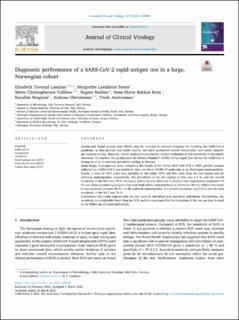Diagnostic performance of a SARS-CoV-2 rapid antigen test in a large, Norwegian cohort
Landaas, Elisabeth Toverud; Storm, Margrethe Larsdatter; Tollånes, Mette Christophersen; Barlinn, Regine; Kran, Anne-Marte Bakken; Bragstad, Karoline; Christensen, Andreas; Andreassen, Trude
Peer reviewed, Journal article
Published version
Date
2021Metadata
Show full item recordCollections
- Artikler [5061]
- Publikasjoner fra CRIStin FHI [7536]
Original version
10.1016/j.jcv.2021.104789Abstract
Background Rapid antigen tests (RATs) may be included in national strategies for handling the SARS-CoV-2 pandemic, as they provide test results rapidly, are easily performed outside laboratories, and enable immediate contract tracing. However, before implementation further clinical evaluation of test sensitivity is warranted. Objectives To examine the performance of Abbott’s Panbio™ COVID-19 Ag Rapid Test Device for SARS-CoV-2 testing in a low to medium prevalence setting in Norway. Study design A prospective study comparing the results of the Panbio RAT with PCR in 4857 parallel samples collected at a SARS-CoV-2 test station in Oslo, and from COVID-19 outbreaks in six Norwegian municipalities. Results A total of 4857 cases were included in the study; 3991 and 866 cases from the test station and the outbreak municipalities, respectively. The prevalence at the test station in Oslo was 6.3 %, and the overall sensitivity of the RAT was 74 %. Increased sensitivity was observed in patients who experienced symptoms (79 %) and when considering samples with viral loads above estimated level of infectivity (84 %), while it was lower in asymptomatic persons (55 %). In the outbreak municipalities, the overall prevalence was 6.9 %, and the total sensitivity of the RAT was 70 %. Conclusions Our results indicate that the test correctly identified most infectious individuals. Nevertheless, the sensitivity is considerably lower than for PCR, and it is important that the limitations of the test are kept in mind in the follow-up of tested individuals.
